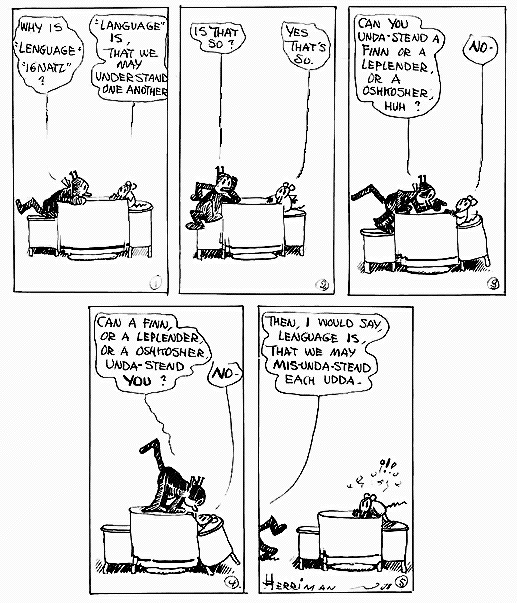
|
Instructor: John
Lawler (jlawler@umich.edu)
Prerequisites: None. This is the basic course, Section 001, 1:00-2:30 TTh, 269 DENN Plus a 1-hour section on Friday, available at various times. |
Credits: 4 Distribution: Social Science (SS) |

True, all true. As Krazy suggests, this "massive and inclusive art" is also the information bottleneck of the human condition. A vast amount of our knowledge, including virtually everything we learn in formal education, comes to us through Language. Consequently, learning to analyze language, in ways that work for all languages, and to describe it objectively, is an indispensable tool for intellectuals, and one that stimulates in addition the habit of close attention to language, which is one of the things necessary for effective writing, not to mention clear thinking. Further, an understanding of how language really works (in contrast to the linguistic mythologies usually taught in schools) gives one a metaphorical place to stand that facilitates the study of anything that is described in language, which means just about everything.
Over the last century, linguistic scientists have amassed an array of analytic procedures, concepts, and findings that allow one to de-mystify speech, grammar, and language use, and to discover a number of surprising facts about one's own and others' languages. This course is a medium-sized (maximum 70) 4-credit intensive introduction to the methods linguists use for describing languages (although general training in analytic thought is our ultimate goal).
Drawing on examples from a large number of the world's languages, after a brief introductory unit we will devote about two weeks to each of the major areas of linguistic analysis, in order:
There will be daily data analysis problems, which will form the context for our discussion. In addition, there will be comprehensive take-home midterm and final take-home exams, which may be done in groups. This class is especially recommended for those with interests in scientific analysis (including mathematics, computing, and engineering), since the analytic methods discussed are generalizable easily.
The text is Crystal's Cambridge Encyclopedia of Language; recommended but not required is the Cambridge Encyclopedia of the English Language, by the same author. These are reference works; the materials for analysis and handouts are in a coursepack at Excel (1117 South University). No prerequisites except an interest in language and thinking.
View the International Phonetic Alphabet (IPA), use IPA in Unicode with SIL fonts, read the Fall 2008 syllabus, see a sample problem set, get some hints for solving them, and see a set of solutions for them.